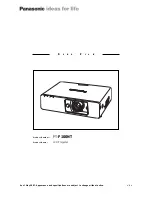
I
n the past few months we’ve seen a
revolution in the video projection
business. A revolution no one ex-
pected. The prices of home theater front
projectors have been dropping nearly as
fast as flat panel displays.
Since the September 2006 CEDIA
Expo we’ve seen the introduction of at
least six 1080p projectors priced at or
below $6,500. We’ve already reviewed
three of them (the Sony VPL-
VW50”Pearl,”, the Optoma HD81, and
the Mitsubishi HC5000. A fourth, the
JVC DLA-HD1, was the subject of a
Short Take a few weeks back. While the
JVC is the most expensive of all of these
models, in many respects it’s also the
most exciting. This is the full review.
At $6,300 (a replacement lamp is
priced at $399), the DLA-HD1 is one of
two new projectors from JVC. The other
is the RS1. According to the company,
they differ in only two ways. The RS1 is
sold through JVC’s professional channels,
and the HD1 is sold through consumer
outlets. In addition, the HD1 is black and
silver (see photo) and the RD1 is all
black. But with respect to features, per-
formance, and price, the projectors are
identical.
Technology and Features
LCoS, or Liquid Crystal on Silicon, is
a variation of LCD technology. Sony uses
a variant of LCoS that it calls SXRD,
while JVC uses the moniker D-ILA for
its LCoS designs. Most LCD devices are
transmissive. That is, the light passes
through the imaging chips and emerges
from the other side, modified as required
by the image to be displayed. This has ad-
vantages—LCD can be used in either flat
panel displays with a backlight or in front
or rear projection applications using a
miniaturized imaging chip and a lamp as
a light source. But LCD also has disad-
vantages. A major downside is increased
spacing between the pixels, a require-
ment to accommodate the near-micro-
scopic wiring needed to pass signals to
those imaging elements. This spacing can
result in the”screen door effect,” which
at its worst can look exactly as that name
implies as the pixel structure becomes
visible on screen, though practically
speaking this is less of a problem today
than it was when panel resolutions were
lower.
In an LCoS design the light source
passes through a much thinner LCD
layer, is reflected, passes back through the
LCD layer, and emerges on the same side
from which it entered. The circuitry to
drive the pixels can therefore be located
behind them rather than between them,
so the spacing between pixels can be
much smaller. This narrow pixel spacing
results in a high”fill factor” in an LCoS
display—that is, more of what you see
on-screen is actual picture information
rather than dead space between the pix-
els. One disadvantage to LCoS is that it
is suitable only for projection applica-
tions, not for flat panels.
Until recently, LCoS was behind DLP
in some aspects of its performance and in
price. DLP has made huge gains in recent
years in improved black levels and in-
creased contrast ratios. And DLP projec-
Tom Norton’s
Favorite under
$10k.
Way under
$10k!
ultimate
AV
Electronically reprinted from March 2007
JVC DLA-HD1 1920x1080 Home Theater Projector
Thomas J. Norton

























